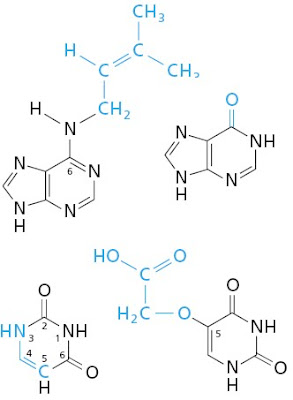From
Science Daily via a press release from NewYork-Presbyterian Hospital/Weill Cornell Medical Center/Weill Cornell Medical College:
RNA Modification Influences Thousands of Genes: Revolutionizes Understanding of Gene Expression.
Over the past decade, research in the field of epigenetics has revealed that chemically modified bases are abundant components of the human genome and has forced us to abandon the notion we've had since high school genetics that DNA consists of only four bases.
Now, researchers at Weill Cornell Medical College have made a discovery that once again forces us to rewrite our textbooks. This time, however, the findings pertain to RNA, which like DNA carries information about our genes and how they are expressed. The researchers have identified a novel base modification in RNA which they say will revolutionize our understanding of gene expression.
Their report, published May 17 in the journal Cell, shows that messenger RNA (mRNA), long thought to be a simple blueprint for protein production, is often chemically modified by addition of a methyl group to one of its bases, adenine. Although mRNA was thought to contain only four nucleobases, their discovery shows that a fifth base, N6-methyladenosine (m6A), pervades the transcriptome.
Those who don't know history are destined to repeat it.
Edmund BurkeWe've known about modified bases in DNA since the early 1970s so there aren't any modern textbooks that don't mention them. If your high school genetics course didn't mention modified bases it isn't because scientists didn't know of their existence—unless, of course, you graduated from high school more than forty years ago.
We've known about the presence of N
6-methyladenosine in mRNA for several decades. Here's the introduction to a 1984 paper by Horowitz et al. (1984).
The most prevalent internal methylated nucleoside in eukaryotic mRNA is N6-methyladenosine (m6A). This modified nucleoside is found in RNAs of higher eukaryotic organisms (1-6), plants (7-9), and viruses (3, 10-12), and occurs at two specific sequences: Gpm6ApC and Apm6ApC (13-17).
Refereences 1-5 are from 1975 meaning that in the published scientific literature the presence of m6A dates back 37 years. That's more than enough time to make it into the textbooks. It's in the textbooks.
Not only that, textbooks also contain references to two other modified bases in mRNA. N
7-methylguanylate is common in cap structures and several mRNAs are known to contain inosine (I), a modified form of adenylate.
I blame the science writers at Cornell Medical Center for writing something that is not true and I blame the authors of the paper for hype and exaggeration and for not correcting the press release before it was published. That's not how science is supposed to work.
[Hat Tip: Uncommon Descent: Is there a fifth base in RNA?]
Horowitz, S., Horowitz, A., Nilsen, T.W., Munns, T.W. and Rottman, F.M. (1984) Mapping of N6-methyladenosine residues in bovine prolactin mRNA. PNAS 81:5667-5671. [PDF]











